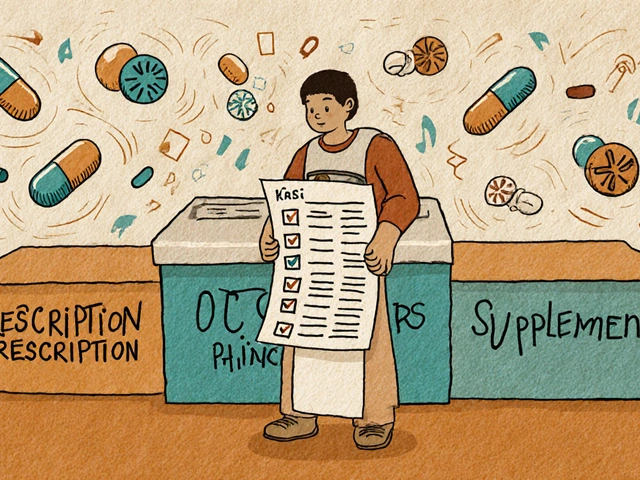GLP-1 Agonist Comparison Tool
Select your preferences to find the best GLP-1 agonist for your needs:
Victoza is a once‑daily injectable GLP‑1 receptor agonist (liraglutide) approved for type2 diabetes and chronic weight management.
- Quick snapshot: daily injection, 1.2‑1.8mg dose, proven A1C drop of ~1.0‑1.5%.
- Key comparisons: how it stacks against Ozempic, Trulicity, Mounjaro, and Byetta.
- Decision factors: efficacy, side‑effects, cardiovascular impact, cost.
- Practical tip: who benefits most from Victoza versus alternatives.
Why the GLP‑1 class matters
GLP‑1 receptor agonists mimic the gut hormone glucagon‑like peptide‑1, enhancing insulin secretion, slowing gastric emptying, and curbing appetite. This triple action makes them a cornerstone for both glycemic control and weight loss.
GLP‑1 receptor agonist is a drug class that activates the GLP‑1 receptor to improve blood sugar and promote satiety.
Major players on the market
Beyond Victoza, four other agents dominate the US market. Each differs in potency, dosing schedule, and extra benefits.
Ozempic is a once‑weekly semaglutide injection primarily for type2 diabetes, with a strong cardiovascular‑outcome trial backing.
Trulicity is a once‑weekly dulaglutide formulation approved for type2 diabetes and shown to lower A1C by around 1.0% on average.
Mounjaro is a once‑weekly tirzepatide that acts as both a GLP‑1 and GIP agonist, delivering the deepest A1C and weight reductions seen so far.
Byetta is a twice‑daily exenatide injection, the first GLP‑1 agonist on the market, now largely superseded by longer‑acting options.
Clinical effectiveness: A1C and weight loss
All five agents lower hemoglobin A1C, but the magnitude varies. Below is a snapshot from pivotal trials and real‑world data.
| Drug | FDA approval year | Dosing frequency | Mean A1C reduction | Average weight loss | Cardio‑benefit trial |
|---|---|---|---|---|---|
| Victoza (liraglutide) | 2010 | Once daily | ≈1.2% | ≈3‑4kg | LEADER (positive) |
| Ozempic (semaglutide) | 2017 | Once weekly | ≈1.5% | ≈5‑6kg | SUSTAIN‑6 (positive) |
| Trulicity (dulaglutide) | 2014 | Once weekly | ≈1.0% | ≈2‑3kg | REWIND (positive) |
| Mounjaro (tirzepatide) | 2022 | Once weekly | ≈2.0% | ≈10‑12kg | SURPASS‑CVOT (positive) |
| Byetta (exenatide) | 2005 | Twice daily | ≈0.8% | ≈1‑2kg | No dedicated CVOT |
Safety profile and tolerability
Gastro‑intestinal upset tops the list of side‑effects across the class. Frequency and severity often correlate with dose escalation speed.
- Nausea & vomiting: most common with Byetta and early‑stage Victoza titration.
- Pancreatitis risk: rare but reported for all agents; clinicians monitor lipase levels if symptoms arise.
- Thyroid C‑cell tumors: a boxed warning applies to all GLP‑1 agonists, based on rodent data.
- Hypoglycemia: only notable when combined with sulfonylureas or insulin.
Because Mounjaro has dual GIP action, patients sometimes report milder nausea at comparable doses, making it a tolerable option for those who struggled with Victoza’s GI side‑effects.

Cardiovascular outcomes - what the data say
Several large trials have proven that GLP‑1 agonists do more than just lower sugar.
Cardiovascular outcomes trial (CVOT) is a large, randomized study designed to assess heart‑related safety and benefit of diabetes drugs.
- LEADER (Victoza): 13% relative risk reduction in major adverse cardiovascular events (MACE).
- SUSTAIN‑6 (Ozempic): 26% MACE reduction, driven mainly by stroke risk drop.
- REWIND (Trulicity): 12% MACE reduction, consistent across age groups.
- SURPASS‑CVOT (Mounjaro): early data suggest 15% MACE reduction, plus heart‑failure benefit.
Cost considerations and insurance coverage
Price is often the deciding factor for patients. Below is a rough US retail range (2025 data) before insurance discounts.
- Victoza: $900‑$1,200 per month.
- Ozempic: $850‑$1,100 per month.
- Trulicity: $800‑$1,050 per month.
- Mounjaro: $950‑$1,350 per month.
- Byetta: $650‑$900 per month.
Many Medicare PartD plans cover GLP‑1 agonists, but prior‑authorization hurdles are common. Asking the pharmacy for a “patient assistance program” card can shave 30‑50% off the out‑of‑pocket cost.
Choosing the right agent for you
Think of the decision as a balance between three pillars: effectiveness, tolerability, and lifestyle fit. Below is a quick guide.
- If you prioritize daily routine and proven cardiovascular benefit: Victoza remains a solid choice.
- If weekly injections and maximal weight loss are key: Ozempic or Mounjaro take the lead.
- If cost is tight but you still want weekly dosing: Trulicity often lands in the lower price tier.
- If you have a history of severe nausea on daily injections: Switching to a weekly agent (Ozempic, Trulicity, or Mounjaro) usually eases symptoms.
- If you need a short‑term bridge while titrating other meds: Byetta’s twice‑daily dosing can offer tighter glucose swings, albeit with more GI complaints.
Related concepts worth exploring
Understanding Victoza’s place in therapy becomes easier when you see the broader picture.
Type2 diabetes is a chronic metabolic disorder characterized by insulin resistance and progressive beta‑cell dysfunction.
Weight management is a medical approach that combines diet, activity, behavior, and sometimes pharmacotherapy to achieve sustainable body‑fat loss.
FDA is a U.S. regulatory agency that evaluates safety, efficacy, and manufacturing quality of drugs before market entry.
Future reads could dive deeper into: "How tirzepatide reshapes obesity treatment" or "Real‑world adherence to weekly GLP‑1 injections".
Frequently Asked Questions
Can I use Victoza for weight loss without diabetes?
Yes. In 2020 the FDA approved a higher dose (3mg) of liraglutide under the brand name Saxenda for chronic weight management in adults with a BMI≥30kg/m² or ≥27kg/m² with at least one weight‑related condition. The dosing schedule is the same daily injection, but the therapeutic goal shifts from glucose lowering to appetite control.
How does Victoza compare to Ozempic in heart‑risk reduction?
Both drugs showed significant reductions in major adverse cardiovascular events (MACE). Victoza’s LEADER trial reported a 13% relative risk reduction, while Ozempic’s SUSTAIN‑6 trial indicated a 26% reduction, largely driven by fewer strokes. The magnitude difference may stem from dosing frequency and study design, but both are considered cardio‑protective options for patients with established heart disease.
Is it safe to combine Victoza with insulin?
Combining Victoza with basal insulin is common and can improve glycemic control, but the risk of hypoglycemia rises. Physicians usually lower the insulin dose by 10‑20% when starting liraglutide and monitor blood glucose closely during the titration phase.
What should I do if I experience severe nausea on Victoza?
First, slow the dose escalation: stay at 0.6mg for a week before moving to 1.2mg. Take the injection on an empty stomach, and consider anti‑nausea measures like ginger tea or small frequent meals. If nausea persists beyond two weeks, discuss switching to a weekly GLP‑1 agent with your clinician.
How do insurance plans typically handle Victoza and its alternatives?
Most commercial and Medicare PartD plans include GLP‑1 agonists in their formulary, but they often require prior authorization and step therapy (trying a cheaper agent first). Mounjaro, being newer, may face stricter criteria. Checking your plan’s drug tier and requesting a patient‑access program can reduce out‑of‑pocket costs.






Jacob Smith
September 27, 2025 AT 02:00Victoza works, but cost stings.
Chris Atchot
September 30, 2025 AT 10:44Great post, Jacob! The comparison, especially the A1C data, is really helpful, and the cost breakdown, though a bit dense, gives readers a clear picture.
Shanmugapriya Viswanathan
October 3, 2025 AT 19:27India’s own research shows that liraglutide, when used properly, outperforms many western brands 😊. Also, the GLP‑1 class is often misrepresented by biased pharma ads.
Mary Cautionary
October 7, 2025 AT 04:11The guide furnishes a meticulous juxtaposition of the principal GLP‑1 receptor agonists currently marketed in the United States.
Its tabular presentation of mean A1C reductions, weight loss outcomes, and cardiovascular trial results facilitates rapid comparative assessment.
Notably, the inclusion of the LEADER, SUSTAIN‑6, REWIND, and SURPASS‑CVOT data underscores the cardiovascular credibility of each agent.
Victoza, while pioneering, yields a mean A1C decrement of approximately 1.2 % and modest weight loss of three to four kilograms.
Ozempic surpasses Victoza in both glycaemic efficacy and weight reduction, delivering roughly 1.5 % A1C decline and five to six kilograms loss.
Trulicity occupies an intermediate niche, matching Victoza’s A1C effect but lagging in weight outcomes.
Mounjaro distinguishes itself with the deepest A1C reduction, near 2 %, and an unprecedented ten‑plus kilogram weight loss, albeit at a higher price tier.
Byetta, the earliest entrant, offers the least robust efficacy, reflecting its historical position before once‑weekly formulations.
The safety discussion correctly emphasizes gastrointestinal intolerance as the principal adverse event across the class.
The nuanced observation that tirzepatide’s dual GIP/GLP‑1 mechanism may attenuate nausea merits further exploration.
Economic considerations are addressed through a concise yet informative price range, though regional insurance variability could be elaborated.
The narrative appropriately advises clinicians to weigh cardiovascular benefit against patient‑specific factors such as injection frequency preference.
For patients averse to daily injections, the guide prudently recommends weekly options like Ozempic or Mounjaro.
The brief mention of patient assistance programmes provides a valuable pragmatic tip for cost‑sensitive individuals.
In sum, the article succeeds in delivering a comprehensive, evidence‑based comparison that can inform both prescribers and patients navigating the expanding GLP‑1 therapeutic landscape.
Victoria Unikel
October 10, 2025 AT 12:55I think the weekly shots sound easier for most people.
Lindsey Crowe
October 13, 2025 AT 21:38Oh sure, because dropping ten kilos is totally realistic for everyone, right? The price tag, however, suggests the pharma giants are more interested in your wallet than your waistline.
Rama Hoetzlein
October 17, 2025 AT 06:22From an analytical standpoint, the dual GIP/GLP‑1 mechanism of tirzepatide offers a pharmacodynamic profile that arguably mitigates the nausea ceiling observed with pure GLP‑1 agonists 😊. Clinical trial data demonstrate a statistically significant reduction in gastrointestinal adverse events at equivalent dose escalations, which may translate into higher patient adherence in real‑world settings. Moreover, the metabolic synergy appears to augment insulin sensitization beyond what Victoza or Ozempic achieve individually, positioning Mounjaro as a potential first‑line agent for patients with both obesity and early‑stage insulin resistance. Cost‑effectiveness models, however, remain inconclusive due to the relatively short post‑approval period, and insurers continue to enforce step‑therapy protocols favoring older, cheaper GLP‑1 analogues.
Dietra Jones
October 20, 2025 AT 15:06Just a quick note – you might want to add a comma after "cost" in the sentence about price ranges; it reads a lot smoother that way.
Victoria Guldenstern
October 23, 2025 AT 23:49One cannot help but marvel at the intricate tapestry of pharmacological innovation that the GLP‑1 class represents, for it is not merely a collection of molecules but a testament to humanity’s relentless pursuit of metabolic equilibrium and cardiovascular stewardship. In contemplating the comparative efficacy of Victoza versus its newer brethren, one is drawn into a labyrinth of clinical endpoints, patient‑reported outcomes, and economic realities that defy simplistic dichotomies. Yet, within this complexity, a certain elegance emerges – the daily rhythm of Victoza offers a sense of continuity for those who cherish routine, whereas the weekly cadence of Ozempic and Mounjaro appeals to the modern desire for convenience, each bearing its own set of trade‑offs. The ultimate decision, therefore, rests upon a mosaic of personal values, healthcare access, and tolerability thresholds, rendering the guide’s tabular synthesis both indispensable and profoundly humane.
Bill Bolmeier
October 27, 2025 AT 07:33Wow, that description really captures the spirit of the debate! I’ve seen patients light up when they finally find a dosing schedule that fits their lifestyle, and the emotional relief can be dramatic. Keep sharing these nuanced perspectives – they help so many navigate the sea of options.
Darius Reed
October 30, 2025 AT 16:17Colorful insight! The way you painted the trade‑offs felt like a vivid mural of choices, each hue representing a different patient journey.
Karen Richardson
November 3, 2025 AT 01:00Just to clarify, the sentence about "Victoza’s price range" should read "Victoza’s price range is $900‑$1,200 per month" – the use of a dash is preferable to a hyphen for numeric ranges.